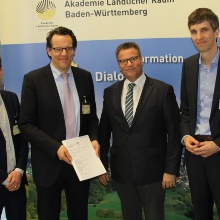The Rural Area of Baden-Württemberg is a very attractive place for working and living. This is the conclusion of the study entitled "Development of Rural Areas in Baden-Württemberg", which was carried out by the Institute of Spatial and Regional Planning (IREUS) of the faculty and the Institute of Regional and Urban Development Research gGmbH (ILS). The study was discussed on January 31st, 2020 in the presence of Minister Peter Hauk in Sulz am Neckar (see photo).
This study provides a broad overview of the overall spatial development of the state, taking into account both the differences between the spatial categories and the subspatial development trends within the rural area. It provides a data basis for identifying dynamic regions, but also regions that face the need for preventive structural change in order to meet the goal of equal living conditions in the long term.
The main results of the economic analysis reflect the positive economic development of recent years and the performance of rural areas in Baden-Württemberg. Thus, all spatial categories underwent an economic development in equal steps until 2016 and reached almost full employment. The share of rural areas in the total gross value added of the state is stable at 28 %. There are hardly any disparities across the country, but rather very small-scale differences in development. In rural areas, for example, individual fast-growing areas such as the districts of Biberach, Tuttlingen or the Lake Constance region stand out from less dynamic regions. Not infrequently, even structurally strong municipalities with above-average dynamics can be found in the direct vicinity of municipalities with structures and dynamics that are well below average. Since rural areas tend to be characterised by these small-scale differences, the promotion of intermunicipal cooperation appears to be an important approach to strengthening equal living conditions. Moreover, the analysis shows that the allocation to area types such as "rural" or "dense" does not fundamentally correspond to prosperity and wealth, and in many places the small and medium-sized enterprises of the manufacturing sector prove to be the backbone of the Baden-Württemberg economy.
The study draws a positive conclusion to a large extent for the infrastructure network of locations, too, which continues to be closely meshed. At least for an automobile population, the travel time required to visit supply facilities remains low. If, however, further concentration processes in the education and health infrastructure cannot be stopped, there is a risk that accessibility in rural areas will deteriorate significantly.
Notwithstanding the overall positive development, two central future risks have been identified: demographic development and the securing of skilled labour. Although the rural area of Baden-Württemberg is characterised by remarkable demographic stability compared to other German states, this has been made possible almost exclusively by international migration in recent years. Without external migration, a population decline would have been evident in rural areas. The reasons for this lie in the death surplus and the negative migration balance with the densely populated area. In comparison, more people moved from rural areas to the densely populated areas than vice versa. The continuing migration of younger people has had a particularly negative effect. This educational migration causes an increasing ageing of the rural area and thus accelerates the decline of the labour force potential. In view of the shortage of skilled labour that is becoming apparent in rural regions in particular, this can be seen as a major risk for the future. The preservation of the economic strength and innovative power of rural areas requires the securing of skilled labour. In this context, medium-sized towns and cities play a central role and have been the driving force behind a positive development in rural areas. They can act as a catchment and anchor for their regional environment and have the potential to stabilise some small municipalities without efficient infrastructure, which are particularly affected by population decline and ageing.
With the knowledge of these future challenges, the IREUS II study recommends finding a middle course between catching up in human capital endowment and the support of the important manufacturing industry. It should urgently be avoided to play off academic and vocational training against each other in a confrontation of educational policy. It is also essential to take preventive action to counteract structural breaks. Therefore, an integrated overall strategy as well as special target processes for structurally weaker regions are recommended in order to further develop rural areas and maintain their sustainability. Last but not least, inter-municipal cooperation is seen as a solution to small-scale disparities.
The three authors of IREUS are available for questions:
Prof. Dr.-Ing. habil. Jörn Birkmann
Dr.–Ing. Richard Junesch
Hannes Lauer, M.Sc.


